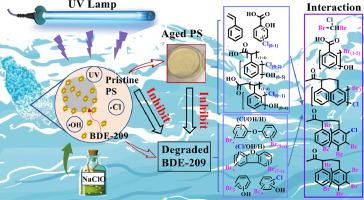Water Research ( IF 11.4 ) Pub Date : 2023-09-01 , DOI: 10.1016/j.watres.2023.120560 Nannan Wu 1 , Wenrui Xiang 2 , Feng Zhu 3 , Zongli Huo 3 , Zunyao Wang 2 , Ruijuan Qu 2

|
This work was to investigate the transformation of coexisting decabromodiphenyl ether (BDE-209) on microplastics and their possible interactions in UV/chlorine process. Compared with pristine microplastics, the highly aged polystyrene (PS) showed an inhibitory effect on degradation of BDE-209. Increasing initial concentration of BDE-209 on PS inhibited degradation, while the chlorine concentration and pH did not affect the final degradation efficiency. Moreover, the presence of NO3−, SO42−, HCO3− and HA in water was unfavorable for BDE-209 degradation. According to the experimental and calculation results, the contribution to the degradation of BDE-209 was ranked as direct photolysis > HO• > •Cl in the UV/ chlorine system. Chlorination products released by PS during UV/chlorination were detected. Four possible reaction pathways of BDE-209 were proposed, which mainly involved debromination, hydroxylation, chlorine substitution, cleavage of ether bond, and intramolecular elimination of HBr. It was worth noting that PS microplastics not only inhibited the degradation of BDE-209, but also affected the type and abundance of its transformation products. Meanwhile, interaction products of PS and BDE-209 were determined, which was attributed to reactions of PS-derived radicals with •Br/•C6Br5 and •Cl. Results of toxicity evaluation showed that the introduction of carbon-halogen bonds, especially C-Br bond, increased the toxicity of chain scission products of PS. This work provides some new insights into transformation, interaction, and associated ecological risks of coexisting microplastics and surface adsorbed contaminants in the UV/chlorine process of drinking water treatment plants (DWTPs) and wastewater treatment plants (WWTPs).

































 京公网安备 11010802027423号
京公网安备 11010802027423号